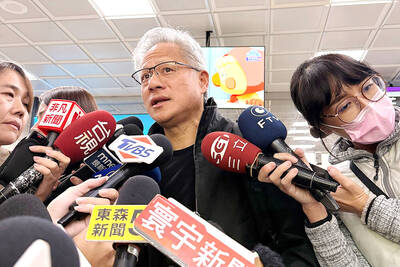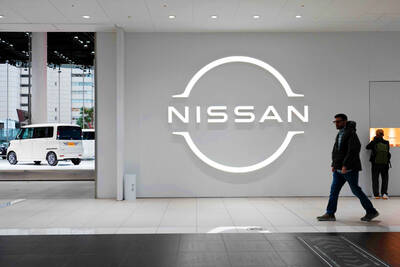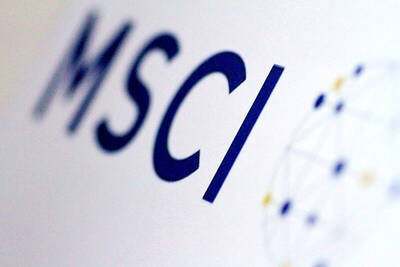Innolux Display Corp (群創光電), which makes liquid-crystal-display (LCD) monitor and flat panels, posted flat earnings in the second quarter as falling monitor panel prices hurt gross margins.
The Miaoli-based company made NT$3.46 billion (US$111 million) in net profits during the quarter ending June 30, compared with NT$3.46 billion a year ago, after deducting first-quarter net profits from its first-half earnings report of NT$6.77 billion.
Revenues, however, grew 15.6 percent to NT$44.52 billion from a year ago. Innolux is an affiliate of the nation’s biggest electronic component maker, Hon Hai Precision Industry Co (鴻海精密).
Innolux’s second-quarter earnings were lower than Morgan Stanley’s forecast of NT$3.81 billion and Citigroup Inc’s estimates of NT$3.51 billion.
“That is because of the price drop in monitor panels,” Innolux financial executive Thomas Hsu (許嘉成) said by telephone.
He declined to give details.
With prices declining, Morgan Stanley analyst Frank Wang (王安亞) forecast that Innolux’s gross margin may have slid by 1 percentage point to 11.3 percent in the second quarter, from 12.3 percent a year earlier.
Hsu provided guidance that “the gross margin will be at a level similar to the first quarter.” Innolux posted a gross margin of 12.29 percent in the first quarter.
“LCD monitor shipments will grow further in the third quarter. Customer inventory levels are healthy,” Hsu said.
Innolux had said earlier that shipments of LCD monitors would increase more than 20 percent sequentially in the second quarter.
Morgan Stanley said in a report on July 15 that Innolux could ship about 8 million LCD monitors in the second quarter and see a 15 percent increase in shipments this quarter.
As the downtrend in monitor prices may continue this quarter, Innolux could see a 36 percent drop in net profits to NT$2.2 billion compared with the second quarter, said Jeff Pu (蒲得宇), who tracks the flat panel industry for Yuanta Securities (元大證券).
Prices for monitor panels are expected to drop by between 12 percent and 14 percent on average in the first half of this month, compared with two weeks ago, market researcher DisplaySearch said.
Panel suppliers may be under heavy pricing pressure this quarter as monitor makers focus on inventory adjustment rather than boosting sales, it said.

PERSISTENT RUMORS: Nvidia’s CEO said the firm is not in talks to sell AI chips to China, but he would welcome a change in US policy barring the activity Nvidia Corp CEO Jensen Huang (黃仁勳) said his company is not in discussions to sell its Blackwell artificial intelligence (AI) chips to Chinese firms, waving off speculation it is trying to engineer a return to the world’s largest semiconductor market. Huang, who arrived in Taiwan yesterday ahead of meetings with longtime partner Taiwan Semiconductor Manufacturing Co (TSMC, 台積電), took the opportunity to clarify recent comments about the US-China AI race. The Nvidia head caused a stir in an interview this week with the Financial Times, in which he was quoted as saying “China will win” the AI race. Huang yesterday said

Nissan Motor Co has agreed to sell its global headquarters in Yokohama for ¥97 billion (US$630 million) to a group sponsored by Taiwanese autoparts maker Minth Group (敏實集團), as the struggling automaker seeks to shore up its financial position. The acquisition is led by a special purchase company managed by KJR Management Ltd, a Japanese real-estate unit of private equity giant KKR & Co, people familiar with the matter said. KJR said it would act as asset manager together with Mizuho Real Estate Management Co. Nissan is undergoing a broad cost-cutting campaign by eliminating jobs and shuttering plants as it grapples

The Chinese government has issued guidance requiring new data center projects that have received any state funds to only use domestically made artificial intelligence (AI) chips, two sources familiar with the matter told Reuters. In recent weeks, Chinese regulatory authorities have ordered such data centers that are less than 30 percent complete to remove all installed foreign chips, or cancel plans to purchase them, while projects in a more advanced stage would be decided on a case-by-case basis, the sources said. The move could represent one of China’s most aggressive steps yet to eliminate foreign technology from its critical infrastructure amid a

MORE WEIGHT: The national weighting was raised in one index while holding steady in two others, while several companies rose or fell in prominence MSCI Inc, a global index provider, has raised Taiwan’s weighting in one of its major indices and left the country’s weighting unchanged in two other indices after a regular index review. In a statement released on Thursday, MSCI said it has upgraded Taiwan’s weighting in the MSCI All-Country World Index by 0.02 percentage points to 2.25 percent, while maintaining the weighting in the MSCI Emerging Markets Index, the most closely watched by foreign institutional investors, at 20.46 percent. Additionally, the index provider has left Taiwan’s weighting in the MSCI All-Country Asia ex-Japan Index unchanged at 23.15 percent. The latest index adjustments are to